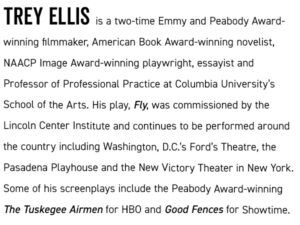Enjoy this exclusive interview between Script in Hand curator Mark Shanahan and Trey Ellis. Trey is an award-winning filmmaker, novelist, playwright, essayist and professor. He is the co-author of Satchel Paige and the Kansas City Swing and will be directing it as our September Script in Hand playreading.
MARK: What inspired you as a writer to focus on Satchel Paige and this particular moment in baseball history for your play?
TREY: The director and my frequent collaborator Ricardo Khan was teaching in Kansas City, home to Satchel Paige and the Negro League Baseball Museum. We thought he was such a unique figure at such a unique time of change that we could find a compelling contemporary story by telling his.
MARK: Your script blends sports history with the broader social and racial dynamics of the late 1940s. How did you approach balancing these themes while telling such a personal tale about the great pitcher’s life?
TREY: I love history, but know that if you don’t tell a personal, emotional story you’re better off writing a history book. I was fascinated by someone who knew he was the best who ever did it, but was barred from competing against white players until he was past normal baseball retirement age.
MARK: Can you talk about your collaboration with Ricardo Khan on the play? How did your partnership shape the development of the story?
TREY: I was a novelist and screenwriter when Rick and Lincoln Center came to me to write a play about the Tuskegee Airmen. I had written the HBO movie “The Tuskegee Airmen” but had never even attempted a play. It was a great learning experience for me and since then I consider myself as much a playwright as any other type of writer. I’ve even moved on to writing the book and lyric for musicals! My “Dorothy Dandridge” musical had two nights of the songs at Carnegie Hall. If Rick hadn’t taken a chance on me back then I’d neve have discovered these new creative avenues.
MARK: How did you go about researching Satchel Paige’s life and the athletes who played in the Negro Leagues, and were there any surprising discoveries that influenced your work on the play?
TREY: There is so much myth surrounding him and his famous quotes. But the people at the Negro League Museum were an amazing resource to discover the real man.
MARK: The play features a mix of historical figures and well as fictional characters. How did you decide which characters to include, and what role do the fictional ones play in telling the story?
TREY: I knew I wanted Satchel, his best friend Buck O’Neil and the best white pitcher Bob Feller. But after that I wanted the freedom to tell the best possible story, using the other characters to shine lights on other aspects of the story and period.
TWO BONUS QUESTIONS!
MARK: How does music factor into the storytelling of Satchel Paige and the Kansas City Swing, and how did you choose to integrate it into the play?
TREY: The first play Rick and I did together, Fly about the Tuskegee Airmen, included a “Tap Griot” a character who commented on the inner lives of the actors through tap. Kansas City isn’t just the home of the best Negro League Baseball team, but also one of the birthplaces of jazz. So we experimented with the “Jazzman” whose saxophone recalls the genius of Charlie Parker to echo the genius of Satchel Paige.
MARK: As someone who has written across various mediums – film, television, and stage – how does writing for the theater differ, and what unique opportunities does it offer for a story like this one
TREY: I absolutely love working in various media. Each provides different advantages and disadvantages, but I now tend to borrow heavily from one to give to the other. Also, in developing projects, something might begin as a film, but then become a TV show and then a play or even a novel. For me, storytelling is storytelling.
For Satchel Paige and the Kansas City Swing, I loved the challenge of a domestic drama mixed with the thrill of baseball and the somewhat fantasy element of the jazzman. If this were a film, this version at least, would lose a lot of its magic.
CLICK HERE or on the the graphics above to read Trey’s full bio.

